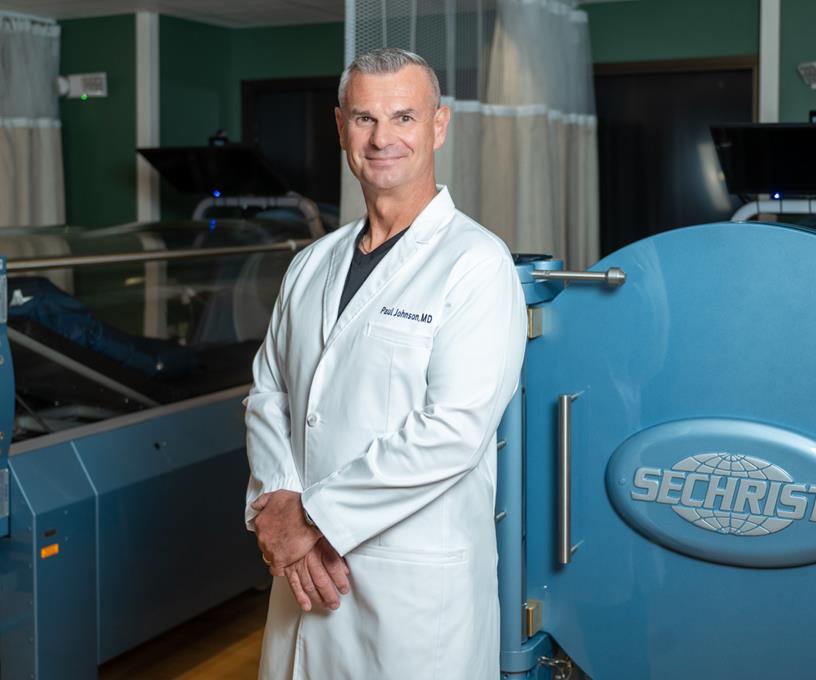

Stethoscope
A Medical Journal of the Volusia County Medical Society
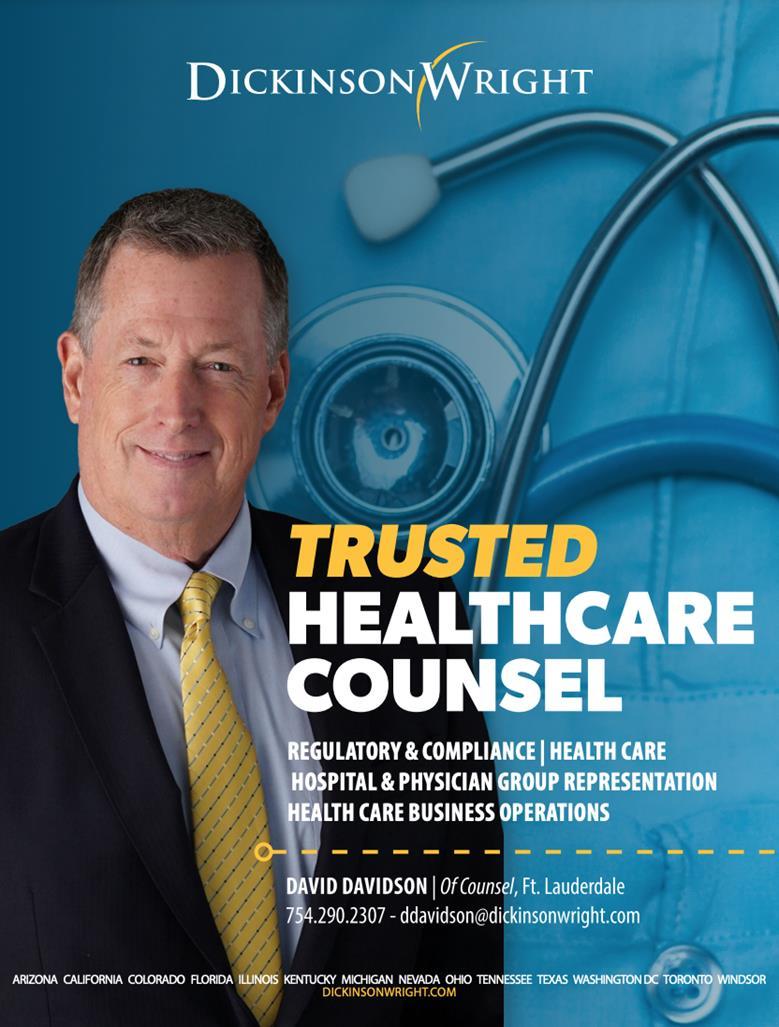
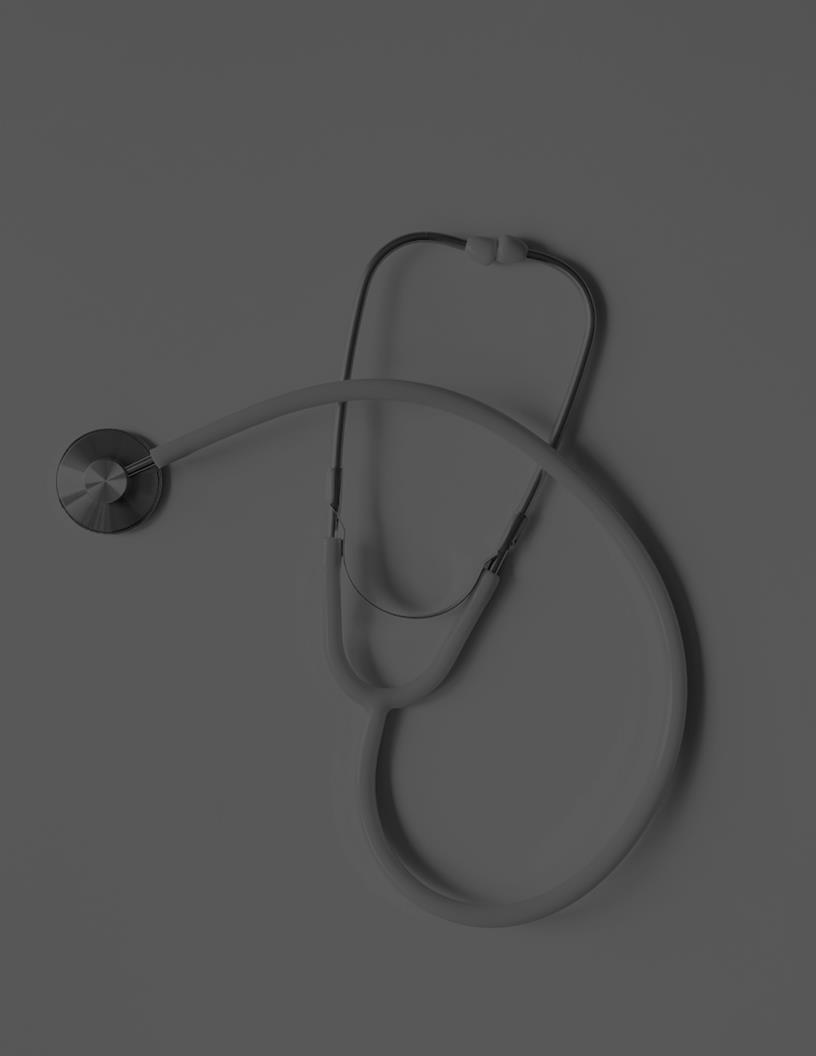
President’s Message:
Amol Gupta, MD
Physical Medicine & Rehabilitation
Dear Colleagues,
It is a great honor to serve as your president of the Volusia County Medical Society.
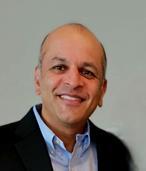
VCMS has a long and proud history and is one of the oldest medical organizations in the state of Florida dating back to 1902. VCMS has had the good fortune of strong leadership and I would like to thank Dr. Feezor for his kind and caring leadership over the past year and for constantly advocating for our society and community
The organization has served the area for over 100 years and maintained an important role in the community in large part due to the Executive Directors I would like to extend a special thank you to Julie Grimm, our current director. Her dedication and behind the scenes hard work has allowed the organization to run smoothly and ensure that we are able to achieve our goals. I would also like to thank our past directors Sami Bay and Gloria Barkin, both of whom were vital to VCMS’ success.
This past fall, my daughter caught me off guard with the following question - what is the purpose Volusia County Medical Society? After a few minutes of contemplating her question, I believe these 4 key pillars are what encompass VCMS: Networking, Social Connection, Advocacy/Education, and Service
1 Networking: As the practice of medicine has shifted from individual practices to large systems, building strong connections with colleagues is crucial to maintain our ultimate goal of patient care I believe it is imperative to know what services are available and who can provide them regardless of affiliation. The relationships we form here allow us to provide the best patient care possible.
2. Social Connection: VCMS also serves as a medium to unwind and connect with colleagues who understand similar challenges we face. Our events and gatherings give us the chance to build friendships and share experiences in a more relaxed environment.
3. Advocacy/Education: VCMS is uniquely positioned to advocate for our patients and our profession in a nonpartisan manner. Through the society, we can educate and advocate for better healthcare policies making a difference in how care is delivered in Volusia County
4 Service: In continuing the work of the previous presidents, I believe VCMS can be an organization of positive influence in the community through service We have volunteered in food kitchens, participated in food and toy drives, donated to causes, and will continue to service the community with a goal of improving the lives of those around us.
I look forward to working with each of you and thank you in advance in continuing to support the Volusia County Medical Society.
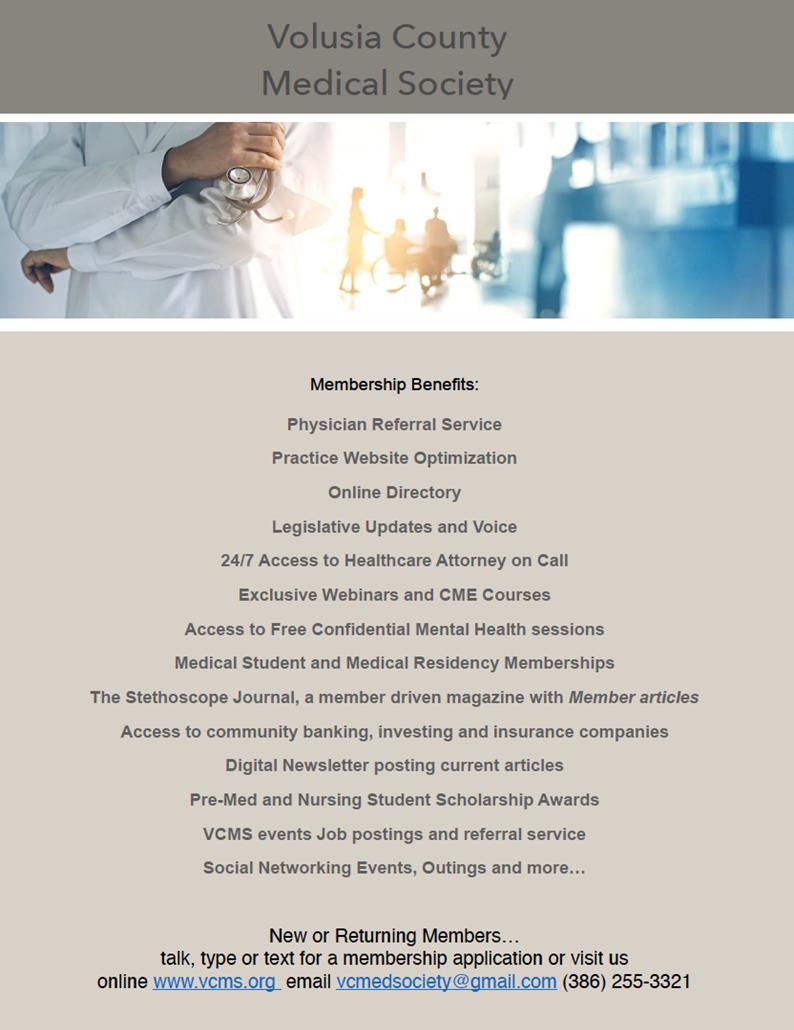

Does
Your MedicalOffice Space Reflect Your StandardofCare?
Easy Inexpensive Improvements to Improve Patient Satisfaction & Compliance -
By Frank Ricci
In today's patient-centered environment, the quality of your care is no longer judged solely by clinical outcomes-it's also evaluated through the patient experience. From the moment a patient walks up to your facility, their perception is shaped by the design, cleanliness, comfort, and functionality of your space.
Your office décor and layout play a measurable role in reducing stress, improving efficiency, and influencing patient satisfaction and compliance. Fortunately, elevating your space doesn't always require a full renovation, here are some simple upgrades you can make to align with modern expectations and Value-Based Care priorities.
12 Easy and Low-Cost Enhancements for Your Medical Office:
1. Paint Walls, Doors & Trim - Use calming, professional tones-such as cool blues, greens, and warm neutrals-to promote a sense of comfort and trust.
2. Improve Lighting - Upgrade to dimmable LED and indirect lighting to reduce glare and enhance visibility and comfort.
3. Integrate Technology - AI-enhanced check-in, QR-coded forms, and digital signage streamline the intake process and reduce wait time anxiety.
4. Control Noise Levels - Install acoustic ceiling tiles, noise insulation, ambient sound or wall panels to protect patient privacy and create a more soothing clinical environment.
5. Upgrade Flooring - Replace outdated or worn materials with slip-resistant, medical-grade LVT for improved safety, aesthetics, and easy cleaning. Add attractive trim for a professional look.
6. Replace Aging Millwork and Surfaces - Exam room cabinets, check-in counters, and worn laminate surfaces can quickly date a practice and lead to poor infection control practices.
7. Install Wall Protection - Chair rails, corner guards, and durable wainscoting help maintain walls and doors, especially in waiting rooms and high-traffic areas.
8. Upgrade Signage - Professional, clearly legible signage improves accessibility and improves branding.
9. Enhance Restrooms – Easy to clean surfaces, modern finishes, and touchless fixtures show infection control awareness.
10. Incorporate Biophilic Elements - Natural textures, greenery, and daylight reduce stress and create a more relaxed setting.
11. Install Calming Artwork – Soothing interior colors and artwork are proven methods to relieve anxiety and reinforce your brand's mission and professionalism.
12. Refresh Exterior Curb Appeal - A clean façade, fresh landscaping, and well-maintained entry reflect positively on your practice.
Each of these improvements supports better patient experience, your patient’s perception of the level of care they are receiving and compliance with directives -all of which influence HCAHPS scores and patient loyalty. As the healthcare landscape evolves, aligning your facility design with the principles of value-based care is not only a branding decision- but a strategic one.
About the Author - Frank Ricci is a licensed real estate broker and certified building contractor with over 30 years of experience in the leasing, sales, design, renovation, and construction management of medical office properties across Florida. For a free consultation, call 407-947-5074 or Email: FrankR@healthcarerealtyonline.com Web: www.healthcarerealtyonline.com

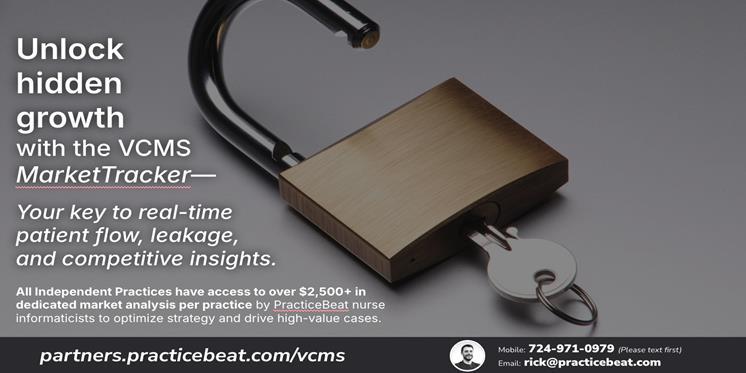
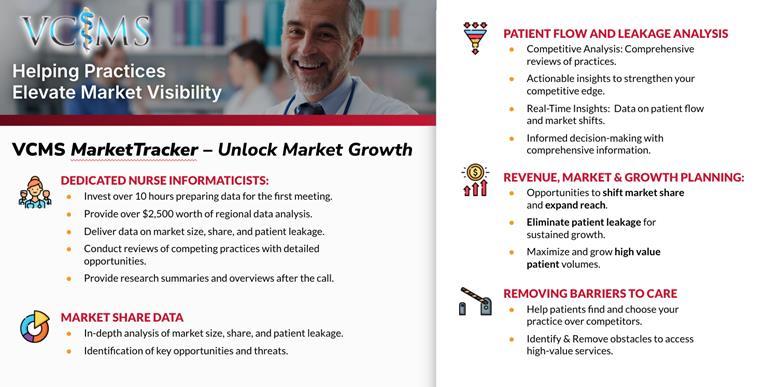
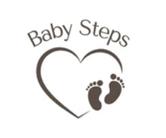
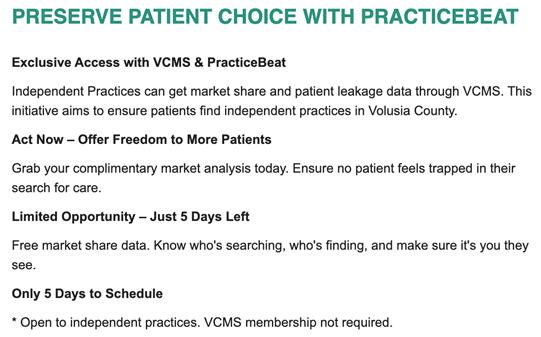
Hyperbaric Oxygen Therapy (HBOT): A Comprehensive Overview
By Paul Johnson, MD, UHMS, ABPM
HalifaxHealth
– Advanced Wound Healing & Hyperbaric Medicine
Hyperbaric Oxygen Therapy (HBOT) has been an innovative medical intervention for numerous chronic and acute conditions for decades, and its applications continue to expand as new discoveries are made HBOT is not only instrumental in wound care but also in managing complex medical conditions by utilizing both the physical effects of pressure and the biochemical benefits of increased oxygen levels
Approved Indications for HBOT in Wound Care
HBOT has shown significant efficacy in treating various wound care-related conditions, particularly those that are challenging to manage through standard medical treatments. Some of the most common uses include:
● Chronic Refractory Osteomyelitis: HBOT promotes healing by reducing infection and enhancing oxygen delivery to bone tissues that are resistant to other treatments
● Soft Tissue Radionecrosis: HBOT helps repair tissues damaged by radiation by encouraging angiogenesis (new blood vessel formation) and reducing fibrosis
● Osteoradionecrosis: HBOT is often used to treat the symptoms associated with radiation to the jaw. By increasing the oxygen tension in the affected tissues, it can help with healing and reduce inflammation.
● Compromised Skin Grafts: HBOT is used for graft salvage in cases where hypoxia or decreased perfusion has compromised viability.
● Diabetic Foot Ulcers: HBOT treatment aims to increase blood oxygen to help repair tissues and restore normal functioning of the body
Scientifically Sound Treatments with HBOT include:
Anemia
Autism
Burn Treatment
Cerebral Palsy
CarbonMonoxide Poisoning
Crush Injury
Decompression Sickness
Dementia
Gangrene
Infectionof skin or bone that causes tissue death
Intracranial Abscesses
Long COVID
Lupus
Lyme Disease
Migraine
Mold Exposure/Toxicity
Multiple Sclerosis (MS)
PTSD
Sports Injury
Stroke
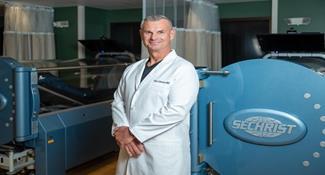
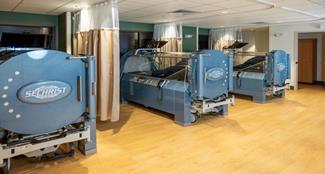
SuddenSensorineural Hearing Loss (SSNHL)
Traumatic Brain Injury (TBI)
Vision Loss; sudden and painless
Cellular and Biochemical Effects of HBOT
The primary action of HBOT occurs on a cellular level, where increased oxygen and pressure work synergistically to stimulate healing mechanisms. HBOT enhances angiogenesis, or new blood vessel formation, which helps in wound healing. It also boosts oxygen levels in tissues, which has a direct bactericidal effect, especially on anaerobic bacteria that thrive in low-oxygen environments."
● Biochemical Changes: HBOT stimulates cellular biochemistry by increasing oxygen availability, which plays a crucial role in:
○ Killing anaerobic bacteria: The elevated oxygen levels inhibit the growth of bacteria that cannot survive in oxygen-rich environments.
○ Enhancing immune response: Increased oxygen boosts the efficiency of white blood cells (leukocytes) in fighting infections.
○ Reducing inflammatory response: HBOT reduces leukocyte adhesion to endothelial cells in the blood vessels, limiting inflammation and tissue damage in the wake of injuries.
Impact on Mitochondria and Oxygen Utilization
Mitochondria, the energy powerhouses of the cell, use approximately 80% of the oxygen that enters the cell. During hypoxic conditions, where oxygen levels are low, harmful free radicals are formed, which can damage cells and lead to apoptosis (programmed cell death).
By restoring normal oxygen levels, HBOT helps correct this hypoxic environment, reducing oxidative stress and promoting cellular survival. This helps to not only facilitate wound healing but also aids in vasoconstriction and angiogenesis, further reducing inflammation.
Genetic Regulation and Anti-inflammatory Benefits
In addition to its immediate effects on oxygen delivery, HBOT also influences gene expression. The pressure exerted at the cellular level promotes the production of anti-inflammatory molecules while simultaneously down-regulating the production of inflammatory ones. This dual effect allows HBOT to not only heal wounds but also reduce the overall inflammatory response in the body, making it effective for chronic inflammatory conditions.
The combination of increased oxygen availability and pressure allows HBOT to influence both immediate biochemical reactions and longer-term genetic regulation, which are essential for reducing inflammation and promoting healing
Conclusion
HBOT offers a wide array of medical benefits, especially in complex wound healing and inflammation control. By understanding both the immediate and long-term biochemical effects, including enhanced mitochondrial function and genetic regulation, healthcare providers can utilize HBOT for a broader range of conditions beyond its traditional uses. With ongoing research, the applications of hyperbaric oxygen therapy will continue to grow, offering hope for conditions previously thought untreatable."
An
Overview of Hyperbaric Oxygen Therapy
Dr. Paul Johnson, MD, Board-Certified Hyperbaric Medicine Provider
Hyperbaric Oxygen Therapy (HBOT) is a treatment where patients breathe 100% oxygen in a pressurized chamber, enhancing oxygen levels in the body and promoting cellular healing. It’s commonly used for nonhealing wounds, radiation injuries, bone infections, carbon monoxide poisoning, and decompression sickness. However, emerging evidence supports its benefits for conditions such as long COVID, traumatic brain injury (TBI), PTSD, migraines, and chronic fatigue syndrome. While insurance in the U.S. may not cover these uses, countries like Japan, Israel, China, and Russia have approved a wider range of treatments.
Is It Safe?
HBOT is considered safe when protocols are followed, ensuring exposure to oxygen and pressure within safe limits. The therapy supports healing by increasing oxygen levels in the bloodstream, fueling mitochondria (cellular energy producers), reducing inflammation, and promoting tissue repair. This effect helps patients with brain injuries, chronic fatigue, and other conditions recover more effectively
What Can Patients Expect?
Outcomes vary by condition and individual. Some patients, like those with long COVID, may see improvements as early as their tenth session Treatment plans at Halifax Health are personalized based on each patient's condition and response, ensuring optimal results
While the U S maintains strict regulations, countries like Israel, Japan, and China provide HBOT for a broader range of medical conditions, backed by extensive scientific evidence demonstrating its effectiveness.
Why Choose Halifax Health - Advanced Wound Healing & Hyperbaric Medicine?
1. Treatment plans are tailored to each patient’s medical history and symptoms for maximum effectiveness.
2. Board-certified, fellowship-trained specialists provide one-on-one consultations and continuous support
3. A physician is present during all treatments, ensuring patient safety
4. Certified by The Joint Commission, Halifax Health upholds high standards of care and safety.
5. Hard hyperbaric chambers with adjustable oxygen pressure enable real-time customization of treatments
To explore HBOT, schedule a consultation with Dr. Paul Johnson, a board-certified hyperbaric physician. Start your journey to recovery today by calling 386 425 HEAL or visiting halifaxhealth org/woundcare

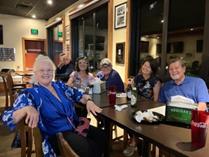
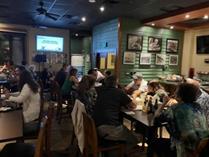
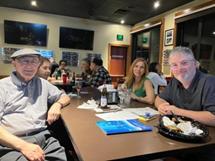
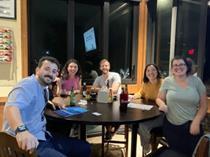
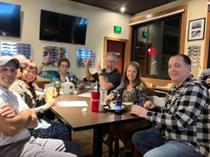
VCMS Holiday Party and Toy Drive Estate on the Halifax
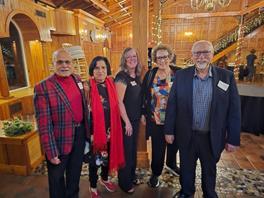
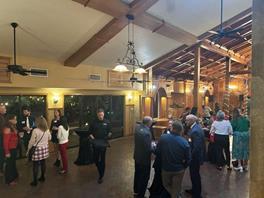



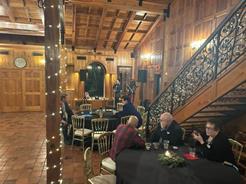


Sponsored by Raymond James
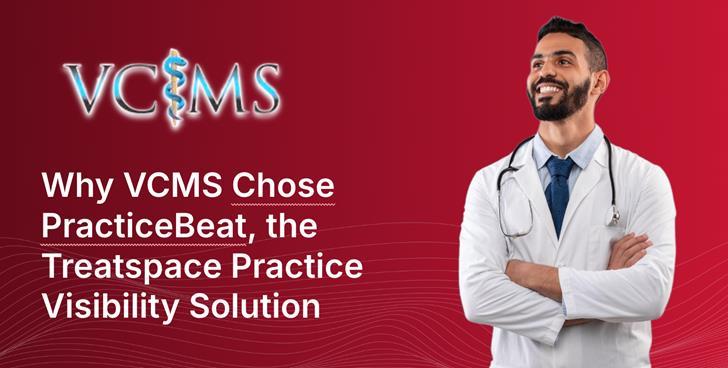
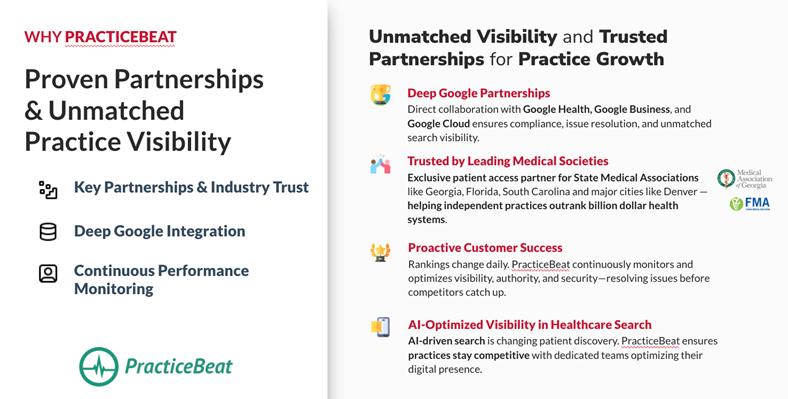
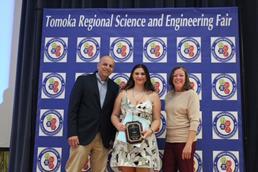
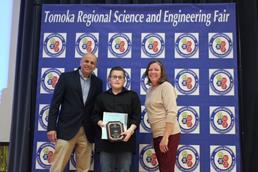
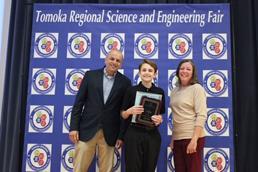
VCMS & Halifax Health Mixer February 2025
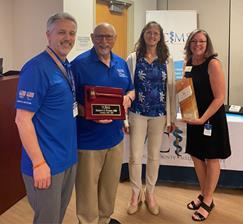
Recognition of Dr. Bob Feezor VCMS President 2024
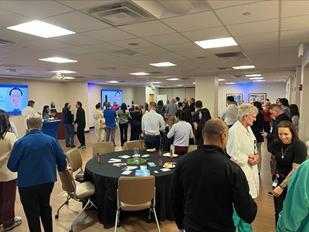
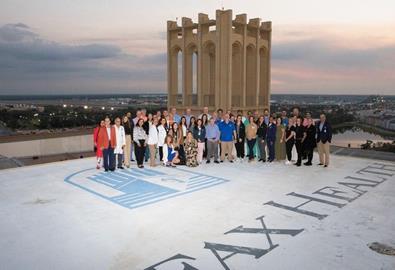
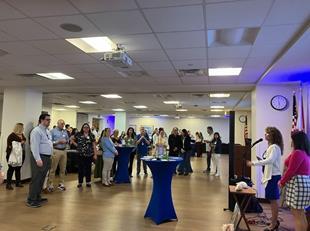
A Unique Collaboration Provides Needed Perinatal Care For Volusia County
Pamela Carbiener MD
Pregnancy is not a disease. But it is a time of increased risk for women. Two centuries ago, pregnancy was a death sentence for those who suffered obstetrical complications that are now preventable or treatable. Prenatal care is intended to identify risks that a woman brings to her pregnancy, such as high blood pressure or substance use, or that a woman may develop during pregnancy such as gestational diabetes. Once identified, these risk factors can be addressed to get the healthiest mom and baby possible.
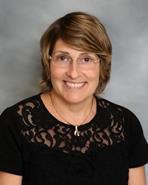
On April 2, a perinatal care clinic, Baby Steps, will begin seeing pregnant and postpartum women at the VCHD building at 421 South Keech Street This will add much-needed capacity for our growing Central East Florida population Located in between the Volusia County Library annex and Halifax Health Pediatrics, this clinic will see pregnant and postpartum women who have not yet obtained their insurance coverage The staff will help women obtain coverage after the initial visit Baby Steps will see pregnant women at any stage of pregnancy and who present with any degree of complexity Should women present with health concerns beyond the scope of Baby Steps, they will be networked to higher levels of care after the initial visit No one will be turned away and no one will leave their visit without a care plan in place
Baby Steps is predicated on a model created by Jennie Joseph, with training available through her Commonsense Childbirth Her model of prenatal care with transition to hospital providers for delivery is successful in places like Dallas, TX and Winter Garden Baby Steps is possible due to a collaboration between the Volusia County Health Department, a private 501c3 and Advent Health Daytona Such collaborations are needed as federal grants and Medicaid reimbursement rates are in flux Without the gracious donation of space, build out and maintenance by Stephen Civitelli, director of the VCHD and the generous support from Advent Health Daytona, this clinic would not be able to open Reimbursement from Medicaid, other insurances and a self-pay program are intended to cover costs once the clinic is running at full capacity But support from our community is needed to secure the clinic during its building phase and sustain the clinic if health care reimbursement and federal grants decrease or become more competitive
Women will deliver at Advent Daytona and Halifax Health Both of these hospitals have excellent laborists who are on site 24/7 These hospitalists provide state-of-the-art obstetrical care Combined with prenatal care provided at Baby Steps, more women will have safer full term births with less complications, decreased hospital stays, and then have a medical home to which they return after discharge from their birthing hospital
Baby Steps will have a weekly clinic that focuses on optimizing mental health in pregnancy It will also treat women in pregnancy and postpartum dealing with the illness of drug dependency Baby Steps will be networking with the many services available in the community for these and other concerns Every visit will offer the opportunity to meet with a navigator to discuss needs of mental health, unstable housing, food insecurity, transportation, legal services, shelter from domestic violence and other concerns On site there is WIC (supplemental help for women, infants and children,) lab services and immunizations Healthy Start, Stewart Marchman Act, Volusia Recovery Alliance, The Chiles Academy, the Halifax Family Practice Residency and Women's Health Fellowship program are just a few of the partners with whom Baby Steps will work to obtain the best outcomes for our mothers and babies
It is unfortunate that the number of obstetrical providers in Volusia County has declined as the number of women needing obstetrical services has increased But resilient communities can provide creative solutions If they are committed, they can sustain those solutions Will the help of our partners and our community, Baby Steps is committed to improving the health and well being of our mothers and their babies
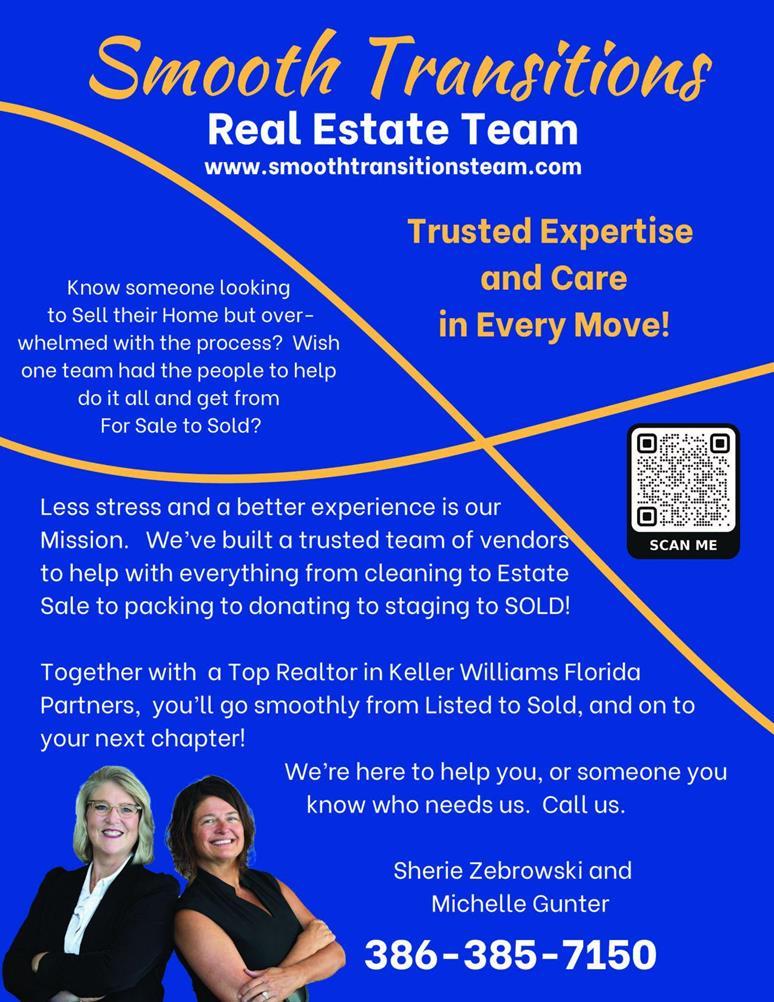
STETHOSCOPE ADVERTISING
OFFICIAL PUBLICATION OF THE VOLUSIA COUNTY MEDICAL SOCIETY
P.O. Box 9595, Daytona Beach, Florida 32120-9595 (386) 255-3321
VCMS Members receive advertising discounts
Approximate circulation: 2200+. Individually distributed to more than 400 physician members of the Volusia County Medical Society as well as Nurse Practitioners, Physician Assistants and medical staff. Also mailed to hospitals and health care facilities in Volusia County, medical societies throughout the state, and health and welfare associations. The publication will also be available online.
The Stethoscope is published twice annually.
All ad copy and artwork must accompany this contract.
All advertising artwork must be digital.
Price includes ad placement in the digital newsletter emailed monthly
Reevaluating Volusia County as a Maternity Care Desert
Lucille J Wilkinson and Jared M Saifman


In 1929, Dr Howard Haggart wrote: "The care of the child-bearing woman is an index of the civilization of the community as a whole and not alone of the leaders of the civilization..." How a community responds to the needs of child-bearing women to assure healthy pregnancy and birth reflects the civility, morality, and forward thinking of that community. Our pregnant mothers bear our children who become our future leaders and productive members of our community. We need to keep this foremost in our priorities.
Volusia county has experienced many changes to its prenatal care landscape over the last 20 years. Changes in legislation and the privatization of Medicaid drastically altered the makeup of prenatal care for underserved mothers in the early 2000s The closing of the Volusia County Health Department prenatal clinic due to these legislative changes hampered mothers’ abilities to enroll in Medicaid on-site and begin their prenatal care immediately. To fill this gap, Halifax Health and Advent Daytona Beach opened new clinics, but these clinics faced new challenges of their own. Furthermore, many extraordinary OBGYNs have retired or moved away over the past several years, creating a vacuum for the patient populations they served. Other practices have been taking on the deluge of patients from these other providers; however, they are still managing their current, constantly expanding patient panels To some relief, the Daytona Beach area is blessed to welcome back three FSU College of Medicine graduates who completed their clinical rotations in Daytona Beach Local OBGYNs continue to preceptor and teach FSU College of Medicine students, yet there is still a great need to fill Volusia county’s need for OBGYNs
Mothers still experience difficulties finding OBGYNs who take Medicaid or offices who will take them as a new OB patient later in their pregnancy. Women are struggling to enroll in pregnancy Medicaid early in their pregnancy due to complexity of the application process and are working through various other social determinants of health that are impinging on their ability to receive quality prenatal care. The women who are receiving little or no prenatal care are consequently developing complications of pregnancy that present acutely in hospital OB triage. Issues of diabetes, hypertension, obesity, domestic violence, and substance use are now belatedly treated in hospital triage units, as women arrive with emergencies that could have been avoided and addressed earlier, less expensively and more effectively. This means longer hospital stays for mothers and babies with long term consequences and costs. OB hospitalists and hospital staff are taxed with managing a constant influx of high-risk OB patients with severe maternal and infant complications, resulting in burnout and stress within the healthcare system. Lack of prenatal care is resulting in worse outcomes for mothers and babies. In addition, women with mental health and substance use challenges are struggling to find clinicians who are capable of managing their complex health issues and often fall through the cracks, adding to burden in our community
The most recent data set of 2023 from FLHealthCharts sheds light on the state of Volusia County and the trajectory of prenatal care in our community Approximately 47% of women in Volusia County use Medicaid insurance to obtain prenatal care. This number has steadily declined since the privatization of Medicaid over a decade ago,15
however it still represents a significant portion of population, especially when only a few OBGYN offices take care of women with Medicaid. Births to mothers initiating prenatal care in their second and third trimesters are increasing steadily, reflecting the number of mothers with unmanaged, potentially higher-risk pregnancies. 32.7% of births were to mothers who were obese at the time pregnancy occurred, which is a number that is increasing from prior years This statistic is mirrored by the steady decrease of births to mothers with healthy weight Women who are overweight or obese while pregnant are more likely to have premature births, large for gestational age babies, increased risk of delivery complications, and babies with birth defects, like neural tube defects. Furthermore, these women are more likely to have complications during labor and delivery, and their babies are at higher risk of developing heart disease, diabetes, and obesity later in life. This finding highlights just one of the complications of pregnancy that needs to be managed during pregnancy with regular prenatal care and is becoming a more common diagnosis in mothers in our community Infant mortality increased from 4 per 1000 live births in 2020 to 5 7 in 2022 Infant mortality rate reflects the health and wellbeing of the population’s women of reproductive age and their infants, as well as the quality of the health care available. Severe maternal morbidity climbed to 30.5% in 2023 in Volusia County compared to the plateaued level of 23% in the state. This statistic indicates the presence of a complications during a delivery hospitalization, which can lead to negative outcomes for the mother and the infant. This rising number is the downstream result of the Volusia County prenatal care landscape and is avoidable outcome.
Creating a culture of safety for pregnant women, our community, the providers who care for them, and the institutions that are charged with their care are essential to solving this issue. All mothers, regardless of race, socioeconomic status, age, identity, and challenges of health, deserve access to prenatal care to curate a safe and managed pregnancy The providers who deliver these mothers in the hospital setting, are hampered by lack of information, and are managing more complex outcomes experience burnout and deserve better from their community.
Perhaps, if enough of us acknowledge this crisis and work to restore care for our women, we can reach 2029, one hundred years after Dr. Haggard’s wrote his book, and show that our civilization is advancing.
The Face of Vaccine-Preventable Suffering
Pavlo Kravchuk, Kyle N. Correll MD, Kevin Salimi

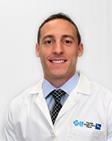

I first met Wanda on a Tuesday afternoon during a routine clinic visit. What wasn't routine was the profound impact her story would have on me. As she settled into the chair across from me, I noticed it took her longer than most each movement deliberate, conserving energy for what would come next. "It's been a long road for me," Wanda shared, pausing to gather strength between sentences, "and I think it's very important that people understand that vaccines can prevent the suffering I've endured." In Wanda's story, I found something statistics alone could never provide: the human face of a vaccine-preventable tragedy.
When Measles Changed Everything
Wanda was born in the early 1950s, nearly a decade before the measles vaccine would become available in 1963.
Like countless children of her generation, contracting measles was considered an almost inevitable childhood rite of passage. What wasn't inevitable yet happened with devastating frequency before vaccination was the development of severe complications.
What began as a fever and rash quickly escalated. Wanda's parents watched in horror as their previously vibrant daughter became increasingly confused, then unresponsive. By the time they rushed her to the hospital, she was experiencing seizures. The diagnosis was measles encephalitis inflammation of the brain caused by the measles virus infiltrating the central nervous system.
For Wanda, that transformation came in the form of a coma that descended like a curtain, separating her old life from what would become her new reality.
The measles virus had caused severe inflammation throughout her brain, with damage to her temporal lobe the area responsible for language processing, memory formation, and emotional regulation. The little girl who had entered the hospital would need to relearn the most basic human functions: how to speak, how to walk, how to navigate a world that suddenly seemed foreign and overwhelming.
A Childhood Redefined
While her peers formed friendships and gained independence, Wanda's days were consumed by rehabilitation Every word relearned and step remastered demanded exhausting effort The isolation deepened her challenges Even on good days, getting dressed drained her before school even began
As Wanda entered adulthood, her challenges evolved rather than disappeared. Temporal lobe damage continued to limit her, complicating relationships due to communication barriers. "People assume speaking means communicating normally," she said. "They don’t see how exhausting it is to find the right words." Everyday tasks like cooking, managing appointments, and socializing required careful planning. On difficult days, even forming sentences felt overwhelming, deepening her isolation.
For nearly five decades, Wanda adapted her life around these limitations. Then, approximately 20 years ago, medical technology offered a new possibility.
A Surgical Intervention
"When the specialist at the University of Florida suggested a partial lobectomy, I was terrified," Wanda recalled. "The idea of brain surgery... but I was also desperate for some relief." Advanced imaging had revealed that her temporal lobe, damaged decades earlier by the measles virus, was still causing significant disruption to her brain's functioning. The surgical team proposed removing the most severely damaged portion a radical intervention that carried significant risks but also the potential for improvement.
The decision to proceed wasn't made lightly For Wanda, it represented both a tremendous hope and a painful acknowledgment that measles had not just temporarily interrupted her childhood but had permanently altered her neurological foundation
The partial lobectomy was successful in improving several aspects of Wanda's functioning Her seizure activity decreased significantly Some cognitive processing became more fluid For the first time in decades, she experienced days where the mental fog seemed to lift, if only partially Yet even this surgical intervention couldn't
undo all the damage from those days of measles encephalitis in her childhood. The surgery improved her quality of life but couldn't restore what had been lost
The Ongoing Reality
Today, decades after the initial illness and years after surgical intervention, Wanda still lives with the consequences of a disease that current generations rarely encounter thanks to vaccination During our conversation, I watched as she periodically needed to pause, gathering energy just to form the words she wanted to share. Simple cognitive tasks that most people perform automatically still require conscious effort for her.
"Getting dressed in the morning can use up half my energy for the day," she explained. "By afternoon, finding words becomes harder. By evening, sometimes I can barely speak at all."
This reality this daily struggle that has defined her entire life stemmed from a disease that today can be prevented with a simple vaccination. The measles vaccine has an efficacy rate exceeding 97% with two doses. Had it been available when Wanda was a child, her life would likely have followed an entirely different trajectory.
When I asked if she had a message for parents considering whether to vaccinate their children, Wanda's expression changed For a moment, the fatigue in her eyes was replaced by an intense clarity
"They just don't understand what they're doing to their child " she began, her voice trailing off as emotion temporarily overtook her ability to form words After a moment, she continued, "This isn't about politics or fear or what you read online. This is about preventing suffering. Real suffering that lasts a lifetime."
Beyond the Individual: The Ripple Effects
Wanda’s story isn’t just about her suffering it’s about how a single case of measles encephalitis sent shockwaves through her family and future. Her parents became full-time caregivers, her siblings grew up in a home where resources were stretched thin, and the life she might have led was lost. Every preventable disease complication is more than an individual tragedy; it’s a communal one. Herd immunity isn’t just a statistic it’s what stands between vulnerable individuals and devastating illness. Before vaccines, everyone was at risk. Many paid dearly.
Practicing medicine in an era of vaccine hesitancy, I often return to Wanda’s story when parents voice concerns. Their fears deserve respect, but so does the reality of vaccine-preventable diseases The anti-vaccine movement frames non-vaccination as a personal choice Wanda’s life disproves that narrative Measles encephalitis didn’t just change her it reshaped her entire family’s future. I share her story (with her permission) to illustrate what measles really means: the fever, the rash, the coma, the years of rehab, the surgeries, the daily struggles.
The numbers are stark 1 in 1,000 measles cases lead to encephalitis, 1-2 per 1,000 end in death, and before vaccines, measles sickened millions annually in the U.S., killing hundreds. But statistics alone don’t convey the loss. Wanda’s childhood was defined by rehabilitation, not play. Her adulthood, by neurological damage, not independence.
Wanda’s Request
Wanda wants her story heard. “If what happened to me convinces even one family to vaccinate,” she told me, “maybe all this suffering had a purpose ” 18
As healthcare providers, we owe it to her and to every patient impacted by preventable disease not to dismiss parents’ concerns, but to make sure they understand the real risks of non-vaccination. When I see vaccine hesitancy, I don’t just see a public health challenge. I see Wanda, gathering the strength to form a sentence. I see her parents watching helplessly as she slipped into a coma. I see the countless families before vaccines existed, mourning what could have been.
And I see our responsibility to ensure this suffering becomes rare, not routine
Our deepest gratitude to Wanda for sharing her story Her courage in reliving these painful memories to protect others exemplifies the best of the human spirit
When Can I Leave?
Madeleine
E Keenan

The first day I met Mr. M he was resting in his hospital bed with his daughter by his side. He was begging to know when he could leave the hospital. It was day 30 of his lengthy hospital stay when I met him. Mr. M had lung cancer that metastasized to his brain. His battle with lung cancer had been years in the making, but Mr. M had an optimistic prognosis. “All” he had ahead of him was to finish fighting off the cellulitis infection he had acquired due to an ulcer on his lower leg. Next, have the debridement of that wound completed and a skin graft place. Then to fully recover from that procedure to ensure that he was medically optimized to undergo a resection of the metastases to his brain. His wife and daughter came daily to visit him, and they were all understandably eager to get out of the hospital room. After continued pleas, he was finally able to go on daily walks outside, a small victory.
Mr. M knew he wasn’t even headed home after leaving the hospital, but to a rehab facility. It didn’t matter, it was closer to home than the hospital. We explained repeatedly that the debridement and skin graft had to happen first to ensure he was strong enough to undergo the tumor resection. Mr. M was a pleasant man, but he was agitated. I didn’t blame him, after a month in the hospital with a lengthy process ahead, I think I’d be agitated too. I imagine he was feeling a whole slew of emotions from optimism to anger to dreaded of the unknown. This was a daunting task at hand. The social, financial, and emotional burden this was taking on he and his family was undoubtedly immeasurable. He often said he just wanted to get out before more people learned he was in the hospital. I wonder if he felt embarrassment, shame, helplessness, etc. I’m sure you can only understand once you’ve lived it and I hope I never have to know.
A few weeks after meeting Mr. M, I was no longer on the rotation where I was seeing him daily, but I did look back in his chart. His oncologist had plead to have the neurosurgery done before having the skin graft placed. The neurosurgeon was confident it would be a minimally invasive resection and having the neurosurgery performed first would allow Mr. M to move to the rehab facility and have the more minor debridement and skin graft placed while in rehab. The oncologist's plea was heard, and Mr. M had undergone his neurosurgery, successfully without complications. He was able to leave the hospital and go to the rehab facility. I hope he and his family are getting some semblance of relief and joy out of this step. Mr. M still has recovery ahead of him but at least he’s a little closer to going home.
The Unseen Ally: How AI Can Lighten the Load for Clinicians
Kevin Salimi, Jared Saifman and Pavlo Kravchuk



Imagine transforming a chaotic jumble of over 1,000 words into a polished, professional draft in less time than it takes to drink a cup of coffee That’s the power of AI what the American Medical Association aptly calls “augmented intelligence ” AI isn’t here to replace our human ingenuity; it’s here to enhance it The magic lies not just in what AI can create from scratch but in how it can refine and elevate our raw thoughts into something truly remarkable
In our interactions with local clinicians, it’s clear that many are overwhelmed and overworked When we ask how they’re alleviating some of this burden with AI, most look at us as if we’ve grown a third head This reaction isn’t entirely surprising The medical field has a well-earned reputation for being cautious about adopting new technologies The stakes are high, and the potential risk to patients demands that new tools be thoroughly vetted before widespread use. However, AI represents a unique opportunity for clinicians to test the waters of technology in a controlled, low-risk environment outside the clinic
It’s fascinating to consider how AI can assist clinicians in ways that go far beyond patient care The common perception of AI is often skewed towards its use in clinical settings diagnosing diseases, predicting outcomes, or personalizing treatment plans While these applications are undoubtedly groundbreaking, there’s immense potential for AI to make a difference in the day-to-day tasks that contribute to clinician fatigue The beauty of AI lies in its versatility and ease of use, but leveraging its full potential requires creativity and a willingness to experiment
Many of us juggle countless responsibilities beyond direct patient care, and these additional tasks often contribute significantly to feelings of burnout Enter AI, a tool that doesn’t require access to sensitive patient information to offer substantial benefits to clinicians For instance, one of our favorite uses of AI is voice-to-text software It allows users to articulate their thoughts freely, without the constraints of grammar or typing precision Instead of laboring over a single paragraph, we can speak our minds, capturing raw, unfiltered ideas We then input these into a generative AI tool such as ChatGPT, which refines them into a polished, professional narrative with just the right tone In minutes, we can transform scattered thoughts into a coherent piece of writing
AI opens up a range of possibilities, from coding functional programs with minimal experience to offering new ways to tackle complex tasks or automate routine processes It can also be used to generate and edit images for marketing campaigns, allowing you to create visually compelling content without needing a graphic design background When it’s time for a break, AI can help craft engaging vacation itineraries, ensuring that every detail is covered for that much-needed R&R Even in the realm of administrative tasks, AI can assist in streamlining the often-tedious process of navigating prior authorization documentation These diverse applications demonstrate how AI can enhance various aspects of a clinician’s daily routine, offering both professional and personal benefits
The takeaway here is that AI is not just a tool for clinical applications; it’s a potential game-changer for the administrative and organizational aspects of medical practice Since the integration of computers into medicine, there has been an increased burden of administrative tasks and documentation, detracting from the core mission of patient care However, AI presents an opportunity to reverse this trend, giving us more time with our patients We encourage
our fellow clinicians to experiment with AI outside of the office. You might discover ways to reclaim small but significant pockets of time whether it’s five minutes here or ten minutes there that can accumulate into a substantial reduction in daily stress. Whether you choose to see more patients with that time or take a moment for yourself, the benefits of integrating AI into your workflow are clear.
Ultimately, AI is an opportunity for us to rethink how we approach our work, not as a replacement but as a partner that allows us to focus more on what matters most: providing exceptional care for our patients while maintaining our well-being and work-life balance. Let’s embrace this technological ally and unlock its potential to enhance our professional and personal lives.
So, to our fellow clinicians: play around with AI. Test its limits, and see what it can do for you. You might find that this unseen ally can help you reclaim some of the time and mental space you so desperately need, ultimately benefiting both you and your patients.
A Familiar Face
Peter Giannas

Roughly 2 months ago was when I began my emergency medicine elective with Halifax health. I was working at the Port Orange hospital, and it was my 3rd shift ever working in an emergency department. My attending physician had sent me in to get a history and physical on a new 62-year-old female patient who came in for “abdominal distention”. Let’s call her KP I spoke to the patient and her husband Learned that they had been married for 35 years and recently moved to Daytona to be closer to their son and daughter-in law and newly born grandchild They had been here for no more than a year and a half when KP started experiencing increasing feelings of bloating and abdominal fullness. This grew to a point where she could not fit into her new jeans that she was so excited to wear, so she decided to see her new primary care physician. They ended up ordering imaging that revealed a large abdominal fluid collection and an ovarian mass concerning for malignancy. KP is now waiting for her appointment with a gynecologist but could not deal with the pain and pressure of her ascites. Her primary care doctor recommended she go into the ER and she is here now asking me if we can “pull off the fluid in my belly ” Ultimately, KP was admitted, IR was consulted, her gynecologist was notified of her hospitalization, and she was eventually moved upstairs I left at the end of my shift and had the rest of my elective at Halifax Daytona Beach. KP was hopeful for the treatment ahead of her and I like to think that her cancer was caught early, and she’d soon fit back into the jeans she wanted to wear.
Two months later, in the final week of my internal medicine rotation all I could think about is the exam I have to take at the end of week. I meet with my attending in the doctor's lounge, and he tells me we are starting this week on the 6th floor. He says this is his least favorite floor because he feels it is the hardest to work on and he always feels emotional about all the patients and their conditions I ask him what the 6th floor is, and he tells me “The cancer floor ”
We get to the 6th floor and go over our admitted patients and my attending lets me pick patients I am interested in seeing and assigns ones he thinks I should see for a good learning experience. We review charts and then I am off on my own to round on my list of patients for the morning. I go and see each of my patients, going down my list, updating my notebook with information from charts, nurses, patient testimonials I finally reach the last patient on my list and go to meet with my attending He says he must go to another floor and meet with a nurse who had a question for a patient, so he asks if I can see one extra patient He points to the patient on my patient list and I’m off to go see the 62-year-old female patient.
I briefly review the patient’s chart before going in and see that she is in the hospital for metastatic cancer. She has been in the hospital for the past 10 days for worsening abdominal discomfort and DVT of the lower extremity. I go into the patient’s room and see that she is asleep. She is bundled up in multiple blankets up to her chin revealing only a skinny and worn face. I see a face that tells me her battle with cancer has not been easy and has taken a toll on her body I start to introduce myself as the medical student working with her hospitalist She wakes up and says it’s nice to meet me and introduces herself as “KP” The moment her name left her lips, I felt an overwhelming rush of recognition. Two months ago, she was a woman full of hope, waiting for answers. Now, she was here frail, fighting, yet still smiling. In the moment I didn’t mention that I had already met her but began asking her about her condition. She goes on to tell me that she has been in and out of the hospital for the past 2 months battling ovarian cancer that has metastasized to her peritoneum and liver. She told me how her body has responded so poorly to outpatient chemotherapy it’s required her to be admitted three times already. She once caught pneumonia and later feared she had it again She told me how her most recent discharge was short lived because she developed a clot in her leg after 2 days of being home and ended up here in Halifax now All I could think about when hearing her story was guilt. How for me, this past two months felt like a blur but for her it was a battle. I thought about the hopes for her that I had when I left the emergency room all those months ago. How none of them came true. She was here, her cancer was worse, and she wasn’t in her jeans.
After some more time speaking with KP, I learned more about her experience as a patient. She was so optimistic and happy to be alive. She said she was lucky to have moved to Daytona when she did since now, she has the support of her son and daughter in law How she experiences immense joy every time they bring her grandbaby How she is lucky to have the support and care of such an amazing team of nurses and doctors who make being a patient so much easier than it could be I was surprised by her sense of humor and how she joked that she always planned to lose weight but “not this much”. At the end of our conversation, I finally told KP that I was the student who met her in the emergency department at Port Orange. Immediately, I felt dumb for saying anything. As if I played an important role in KP’s journey so far. After a moment of silence, she spoke again. She said, “Oh yes I remember, well I hope school hasn’t been to rough to you these past couple months – I know it can be hard.”
Her words took me by surprise. After everything she had endured the pain, the setbacks, the endless hospital stays she was thinking about me I had walked into her room expecting to comfort a patient, but instead, she was the one offering kindness, as if my struggles could ever compare to hers In that moment, I understood that strength isn’t just about fighting battles it’s about holding onto compassion, even when life has given you every reason to let go. KP was facing something unimaginable, yet she still had space in her heart for someone else. That kind of resilience, that kind of grace, is something I will never forget."
A Cowboy’s Last Ride
Lauren Frankle

Bay C-55, 65-year-old male, COPD exacerbation, metastatic melanoma Sometimes in medicine, that is all we see when we meet a new patient: their age, sex, chief concern, and any relevant medical history. But behind these clinical facts, there is always a story waiting to be heard.
The man in bay C-55 helped pull me out of the world of diagnoses and treatments and bring me back to reality, to humanism. This man was not just a gentleman with metastatic melanoma and COPD; he was a world champion rodeo cowboy. Sitting in front of me was a man whose life was marked by courage. A man who tamed wild horses and conquered the rodeo arena His resilience was even more profound After his parents could no longer manage the family ranch in Tennessee, he stepped up, taking on the responsibility of running it alone And then, tragedy struck: he lost his wife, daughter, and grandchild in a devastating car accident Now, five months into a six-month prognosis after being diagnosed with metastatic melanoma, he had moved to Florida, saying simply that he had “come to Florida to die.”
His last wishes were simple: comfort, a regular diet in the hospital, his Marlboros, and to share with me his story. As we spoke, I wondered about his thoughts being in a place like this. Instead of the familiar sounds of crickets singing him a lullaby as he went to bed, he was lulled to sleep by the rhythmic beeping of the monitors in his room. He had spent most of his life surrounded by nature and the freedom of the range; now confined to his hospital room, it must have felt completely foreign
He did not speak much of fear of dying and the unknown, but I sensed it in demeanor With no family left and no one to recount his legacy, I felt the weight of his loneliness. Yet, he thanked me for listening, for allowing him to reflect on his life and share his story with another in his last days. In that moment, I understood how vital human connection is, even for the strongest among us.
His wishes seemed focused only on simplicity and dignity. He had no grand requests, no need for elaborate interventions. He requested only comfort and the ability to hold on to two small pleasures: his cigarettes and a regular diet so he could eat a cheeseburger in the hospital.
The cowboy’s story serves as a powerful reminder that hospitals are not just places of healing, but also where the last chapters of life unfold In those moments, true care goes beyond medicine It’s about listening really listening to the person in front of you It’s about honoring their story, their dignity, and the quiet strength that carries them through their final days.
It was a privilege to share in his final chapter, even for a brief moment.
A Work of Art
Tala Tello

"Go help the nurse." Dr. B’s words rang in my ears as I stepped into the room, my heart pounding. It was the second week of my OBGYN rotation, and I was about to witness my first vaginal delivery. The mother, a 27-yearold woman in her first pregnancy, sat calmly on the hospital bed, her face betraying none of the intensity of what was happening inside her body She looked as if she had come in for a routine check-up, not the defining moment of bringing life into the world. I, on the other hand, felt anything but calm. Not even ten minutes in, and all I could think was how terrifying motherhood seemed. The physicality of it, the raw, unrelenting force of labor it was overwhelming.
I could never do this, I could never be a mother after this experience I thought. Not now Not ever I drifted into my thoughts, barely processing the moment, when I suddenly realized the room was no longer just me, it was now full Dr B and a team of nurses had gathered, each one moving with quiet precision The energy shifted. It wasn’t just a delivery room anymore; it was a canvas in progress, each person adding deliberate strokes to a masterpiece yet to be completed.
Dr B handed me a gown and gloves "Stand next to me " Panic flickered in my chest "I’m not equipped to do this This is only my second week of OBGYN my second week of the clinical year There is no way I can do this " As if reading my mind, Dr. B’s calm voice cut through the chaos.
"I’ll have my hands on top of yours I’ll guide you " And suddenly, I wasn’t just watching I was painting alongside them. I felt the weight of the baby’s head in my hands, guided by hers. A delicate, fragile new life slipping into the world, taking its first breath, crying its first cry a splash of vibrant color against the stark white of the hospital room. The mother reached out, arms trembling but steady, ready to embrace the life she had carried for nine months. The father, eyes brimming with tears, cut the umbilical cord a final brushstroke connecting the past to the future The moment was captured frozen in time, like one of Monet’s sunlit water lilies, each petal a piece of the new family’s story, glowing against the still waters of the room The nurse clicked the camera, and for a moment, we all stood still, witnessing the completion of a masterpiece a portrait of life, a beginning, forever documented
In that moment, it felt like witnessing a masterpiece come to life painted in the cries of a newborn It was like watching Monet complete a painting right in front of my eyes, each brushstroke deliberate yet filled with an energy beyond control. The doctors and nurses were the artists, the mother and father the paint, blending to create something entirely new. And the baby the final work of art was pure potential, a canvas yet to be filled with the colors of life.
As I stepped out of the room, the weight of the experience lingered. I found myself wondering perhaps, one day, I too would be part of such a masterpiece, creating something that would bloom like a Monet garden in full color.
A Blood Test for Colon Cancer Screening?
Nikita Kostrubsky

Colorectal cancer (CRC) is the third most diagnosed cancer in the United States, with early detection preventing over 90% of related deaths. However, more than one-third of eligible individuals are not up to date with screening.1 Traditional methods like colonoscopy, while effective, are invasive and can discourage participation. Recent advancements in blood-based screening tests, such as Guardant Health’s Shield test, offer a potential solution to improve adherence, detect cancer earlier, and ultimately reduce CRC-related mortality.
The Shield test is a blood-based screening that detects changes in cell-free DNA (cfDNA) linked to colorectal cancer and precancerous lesions. In July 2023, the FDA approved the Shield test for primary screening in individuals at average risk. This approval was based on the ECLIPSE study, which included nearly 8,000 participants. The study demonstrated that the Shield test identified colorectal cancers with 83% sensitivity and had a specificity of 90%. However, its sensitivity for detecting advanced precancerous polyps, such as adenomatous polyps, was significantly lower, at just 13%.1
While the test’s high sensitivity for detecting cancer is promising, its inability to effectively identify precancerous lesions highlights a key limitation. Colonoscopy, which allows for the removal of these polyps during the procedure, remains superior for detecting and preventing cancer through the identification of adenomas. Despite this, the Shield test's non-invasive nature provides a compelling advantage. It only requires a simple blood draw, making it more convenient than colonoscopy or stoolbased tests like FIT or Cologuard. This convenience could increase screening rates, especially among individuals who avoid traditional methods due to discomfort or inconvenience.
The Shield test may also play a role in closing the screening gap ss approximately 22% of eligible adults do not undergo regular CRC screening.2 While the Shield test might not completely replace colonoscopy, it could lead to higher screening participation, especially among individuals who are reluctant to undergo colonoscopy. In this regard, its role as an adjunct to current screening methods could enhance early detection, though follow-up colonoscopy remains necessary for individuals with positive results.
However, challenges remain, particularly concerning cost, insurance coverage, and the frequency of testing. The Shield test’s cost-effectiveness and its role in the broader screening framework remain to be fully determined. While a blood test is more convenient than stool collection or colonoscopy, the key to its success will be ensuring that individuals follow through with necessary follow-up procedures after a positive result.
In conclusion, Guardant Health’s Shield blood test holds great promise for improving colorectal cancer screening by offering a non-invasive, easily accessible alternative. Its strong sensitivity for cancer detection and high specificity could increase screening participation and reduce mortality. However, its lower sensitivity for precancerous lesions, coupled with logistical factors such as cost and follow-up procedures, will need to be addressed for it to achieve its full potential in the fight against colorectal cancer.
1. Chung, D. C., Gray, D. M., 2nd, Singh, H., Issaka, R. B., Raymond, V. M., Eagle, C., Hu, S., Chudova, D. I., Talasaz, A., Greenson, J. K., Sinicrope, F. A., Gupta, S., & Grady, W. M. (2024). A Cellfree DNA Blood-Based Test for Colorectal Cancer Screening. The New England journal of medicine, 390(11), 973–983. https://doi.org/10.1056/NEJMoa2304714
2. Richardson LC, King JB, Thomas CC, Richards TB, Dowling NF, Coleman King S. Adults Who Have Never Been Screened for Colorectal Cancer, Behavioral Risk Factor Surveillance System, 2012 and 2020. Prev Chronic Dis 2022;19:220001. DOI: http://dx.doi.org/10.5888/pcd19.220001
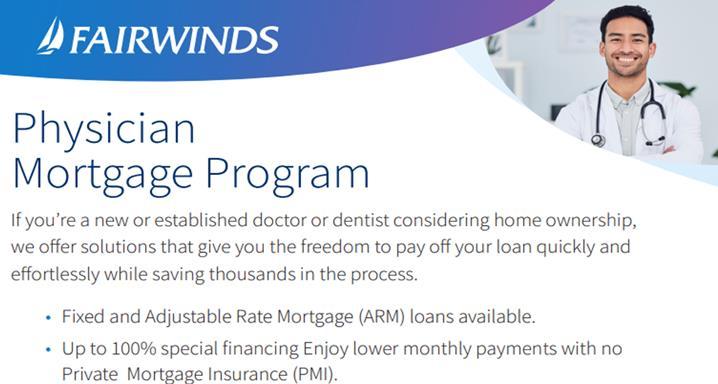
Teri Craddock
Vice President, Business Development Officer
386.295.3959 | cell: 386.846.0209 208 S. Nova Road, Ormond Beach, FL 32174

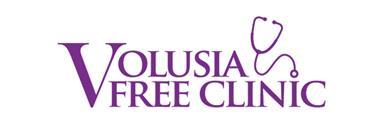
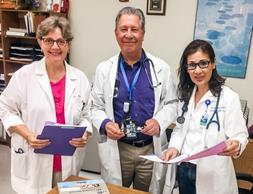
The Volusia Free Clinic, also known as the Volusia Volunteers In Medicine (VVIM), a 501(C)(3) organization, provides free primary healthcare to low-income, uninsured residents between the ages of 18-64. We are a volunteer-driven organization with only one part-time paid Office Manager VVIM, also known as Volusia Free Clinic, benefits Volusia County by providing a healthier workforce, reducing paying hospital and emergency room visits and building a strong sense of community.
Our office manager schedules patients by appointment only at our Daytona Beach and New Smyrna Beach locations. In early 2025, our Daytona Beach location is moving to a permanent address where more exam rooms and areas for patient care will expand Our website VOLUSIAFREECLINIC COM will have current information about the expansion, appointments available and types of care Laboratory tests, X-rays, even MRIs and CT scans are provided for free or with discounted rates These services can be very expensive under normal circumstances and especially expensive if no insurance is available.
For more than ten years, VVIM has provided FREE medical care through private donations, small fundraisers and grants. We are looking for volunteer doctors and nurses who would like to serve their community. Retired or semi-retired medical professionals are the backbone of our organization We are specifically in need of a cardiologist and primary care physicians who can volunteer time at our clinic or who will see our patients in their office. Any physician who provides their services free of charge, whether at our clinic or at their own private office, is covered under the State of Florida sovereign immunity law.
Anyone who is interested in joining our team or finding out more information, please contact our office at 386-316-2771 or email at vvimmanager@gmail.com.
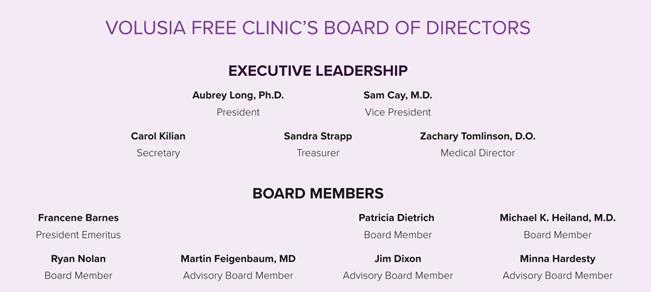
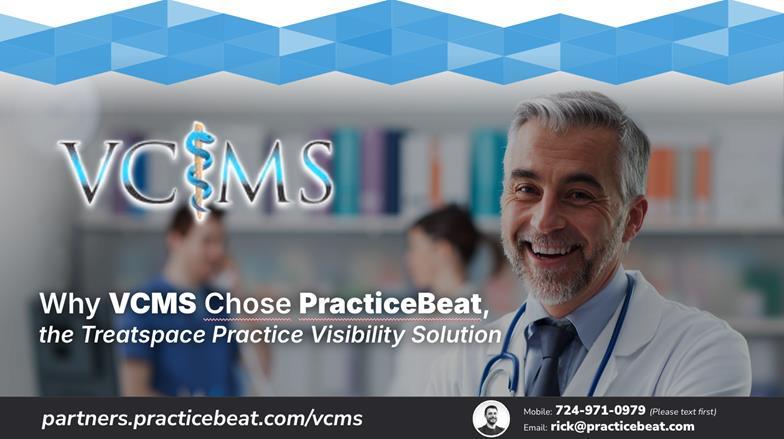
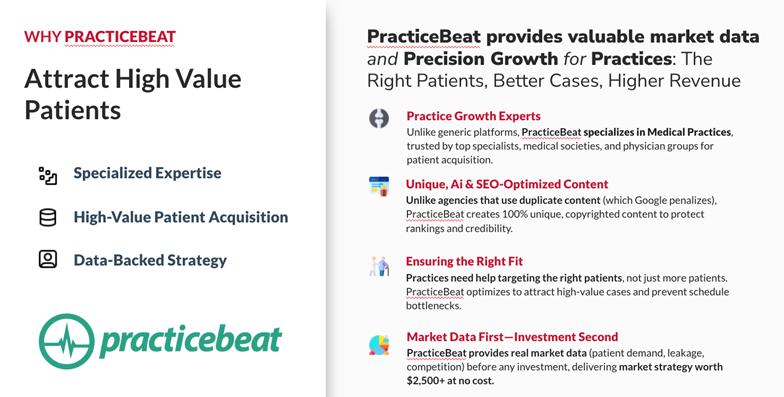
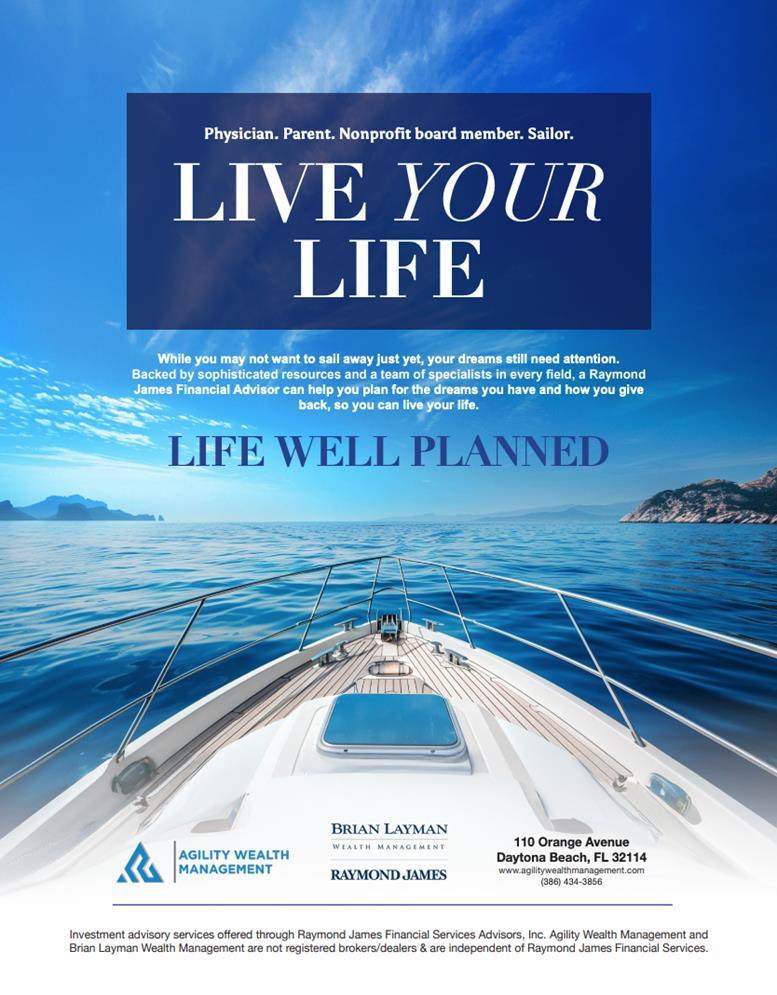


Food For Thought Goes Overboard
For many years I have only written reviews about restaurants in Volusia County. Now for something completely different. Living in Florida many vacations are spent cruising out of nearby ports. Florida residents get special discounts on cruises along with many perks As we raise our families, we often take our children with us as most cruise lines today cater to families Having gone on at least one to two cruises per year over the last 41 years, I have dined in many exclusive restaurantsaboard these ships There is usually one good restaurant on each ship with an upcharge Recently Lisa and I tried a different line that featured independent restaurant dining to the nth degree. The basic cruise fare covered 20 plus restaurantsaboard the ship. There was no upcharge for any of them. This ship contained no grand buffet where people could grab food with their hands. Instead, there was a food court where food was served to you by staff wearing gloves. One could order a dish at the counter or you could sit at a table where there was a little flag that you would raise, and a waiter would come over to you and ask you what you would like from any of the 10 counters and coffee bar He would happily get it for you No way could you get norovirus from this type of service Some of my favorite dishes in this area included Thai Ramen bowls, Bento sushi boxes, Lox, bagel and cream cheese Mocha lattes too! All restaurants on the ship had menus for vegetarians, vegans, and meat lovers. Many of the menu items aboard this ship were created by Michelin starred chefs. This included Brad Farmerie who ran the restaurant PUBLIC (now closed) in New York City as well as Sohul Kim, who runs the Good Fork and Insa in New York City aswell.
The first night aboard the ship Lisa and I dined at a restaurant called the Test Kitchen At this restaurantthe chef goes all out creating eclectic dishes for both vegetarianand non-vegetarians alike We ordered off the standard menu, but our waiter brought us the vegetarian items to enjoy as well. Believe it or not, I enjoyed most of the vegetarian items more than the regular items. This included the best gazpacho we ever had. On the standard menu, I must say the way they presented a duck pâté between 2 sugar wafers which was outstanding and extremely flavorful. I opted for a venison tenderloin served on a plate with a chocolate tree branch melted on top Lisa had the filet served the same way Both were Incredible Check out the photos
Another night we ate at Pink Agave, an upscale Mexican restaurant. Here we both enjoyed one of the best rib steaks ever The were rubbed in chili ancho and covered with melted oaxaca cheese This came with russet potatoes and succulent roasted corn that was outstanding
The night that we ate at the Wake Steakhouse I decided to have fish. The snapper came out perfectly cooked with a caper lemon butter sauce This also came with a twice baked potato and caramelized onions that just melted in your mouth Lisa thoroughly enjoyed her New Zealand rack of lamb with creamed spinach and mushrooms


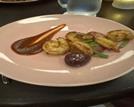
The restaurant in which we had the most fun is called Gunbae. This is the only Korean barbecue restaurant found on any cruise line. One enters this restaurant and is seated at a round table serving eight people with the grill in the center. After the waitress came and took your order on what kind of meat or veggie you wanted to be cooked in front of you, another waitress came with shots of a potent but flavorful Korean liquor mixed with vodka which was passed out to each of us We then played a drinking game It was a round in which you started with the number one and proceeded from there Every time you hit either a three six or nine you had to clap and not say the number. If you had two threes such as in 33 you had to clap twice. Needless to say, if you missed the number you had to do the shot. I don't remember much after that except the food was wonderful and we made a lot of friends that night.




If you found yourself being hungry at 3:00 in the morning you could make your way over to the 24-hour breakfast bar and indulge in many varieties of breakfast including eggs your way, avocado toast, and huevos rancheros. Even their coffee bar was outstanding During the afternoon you could make your way to the back of the ship where many Mediterranean tapas were served, or you could go to the pizza restaurant and even the homemade ice cream parlor You could also indulge in High Tea (the ship is British) High Tea was a slight upcharge Everything else was included in your basic cruise fare. This ship also included free Internet. Water, soft drinks and juices were also free. This ship did not nickel and dime you asmost others do.

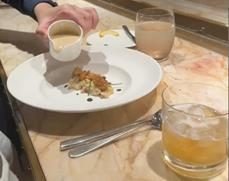
The cruise line and ship we sailed on is the Valiant Lady. This is owned by Richard Branson who also owns Virgin Air It leaves out of Miami This cruise line does not allow children under the age of 18 The average age of the passengers is 46 No smoking allowed except in designated sealed off rooms I was one of the older ones, but I still loved every minute of it. They cater to all walks of life without bias. The entertainment can be bawdy at times but it's usually great fun as well. The staff and service were impeccable. If you need any other information about this cruise line, I would be happy to talk to you about it in private
Quality of food: 5 stethoscopes
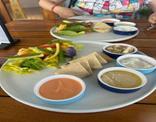

Ambiance: 5 stethoscopes
Value: 5 stethoscopes
Service: 5 stethoscopes
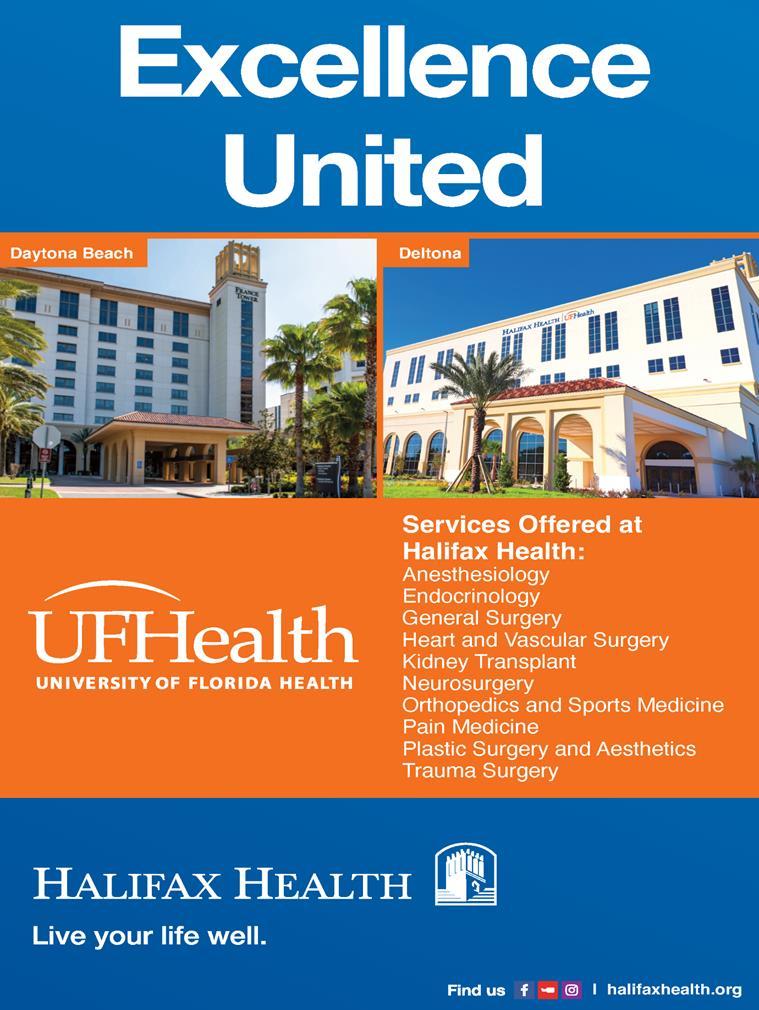
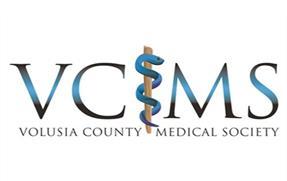
PO Box 9595
Daytona Beach, FL 32120
Are you a physician in Volusia County seeking to explore the benefits of joining a medical society?
Membership Benefits:
● Physician referral service
● Online directory
● Legislative updates and voice
● 24/7 access to an on-call healthcare attorney
● Exclusive webinars and CME courses
● Access to free confidential mental health sessions
● Annual Daytona State College scholarship partnership
● The Stethoscope Journal, a member driven magazine with member articles
● Access to community banking, investing and insurance companies
● A monthly digital newsletter posting current articles, legislative news, and VCMS events
● Job postings and referral services
● Social networking events, outings and more…

VCMS memberships are also available to medical students and residents seeking to become involved! New or Returning Members – talk, type, or text for a membership application or visit us online www.vcms.org / vcmedsociety@gmail.com / (386) 255-3321
